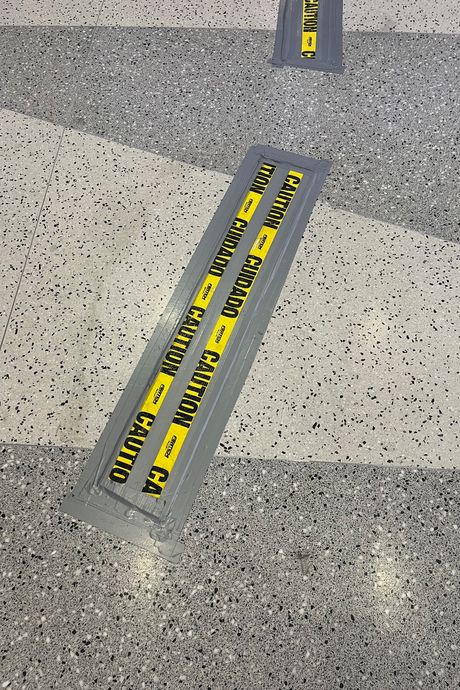The Floors in Grand Central Madison Cracked Before It Opened

If you went through Grand Central Madison in the past three months or so, you likely saw something going on underfoot. The terrazzo floor on the mezzanine was spiderwebbed with yellow CAUTION tape and silver duct tape, clearly covering cracks of some kind. It was an unattractive thing to encounter in such a new and expensive piece of infrastructure. Grand Central Madison, after all, was (if you include the tunneling that brought trains to the terminal) an $11 billion project, two decades in the making. Surely we had the best of the best? It’s not quite as dispiriting as the crumbly Oculus floor, but it’s not great either.
I got curious about this—what’s going on, did someone screw up, etc.—and hit the usual roadblocks. The MTA told me its people were investigating what had caused the problem, but wasn’t able to share details. I called Tutor Perini, the contractor that built a lot of the terminal; no response. I tried Platinum, the terrazzo specialist that proudly shows that same mezzanine floor on its website: no response there either.
When I checked back in a few days ago, the tape was gone and so were the cracks. You could see patching here and there if you looked closely, but the floor was sound again. Still, there was a mystery: Why did this brand-new terminal already need repairs?


Crack repair, during and after. From left: Photo: Christopher BonanosPhoto: Christopher Bonanos
Crack repair, during and after. From top: Photo: Christopher BonanosPhoto: Christopher Bonanos
Terrazzo — essentially cement mixed with variegated gravel, ground smooth once it hardens — is a great choice for an institutional floor like this. It is tough as anything, even under heavy service. With care, it’s good for a century or more, and it can be resurfaced and polished many times to look like new. But obviously any concrete-like material will be likelier to crack, should the substructure move beneath it, than more flexible surfaces. I’m no engineer, but that seems like what happened here as the terminal was completed.
Once the repairs were made I reached out to the MTA again, and while its representatives still wouldn’t clarify exactly what had caused the damage, they did fill me in on a timeline. Meghan Keegan, an MTA spokesperson, explained to me that the cracking had occurred during the late stages of construction, before the terminal went into service. The agency had sized up the damage and decided that, since it wasn’t a tripping hazard, it shouldn’t delay the opening. The cracks went on a punch list and were patched months later. The repair procedure involved widening the thin fractures so they could accept new material — you’ve likely seen a similar process if you’ve ever had to fix a plaster wall — and that was the disfigurement, taped over, that I encountered in December. No one will elaborate about whether there was an underlying problem that needed addressing, One hopes there wasn’t—that it was just something temporary, like construction-related vibration.
The band up the center of the photo shows a repair that, it appears, still needs buffing out.
Photo: Christopher Bonanos
You’ll perhaps be pleased to learn, at least, that you didn’t pay extra to fix all of this. The contractor that left us with the problem — the MTA won’t disclose which one it was — repaired it under warranty. Per the official statement that the MTA sent me. “You don’t let a chip in the paint stop you from moving into the house, but you do patch it afterwards. We’re proud to have served nearly 35 million riders and counting since Grand Central Madison opened.”
Source link







